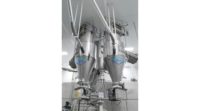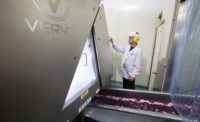Customers of ingredient handling equipment are focused on a wide mix of factors to come up with their optimal formulation. These include accuracy, traceability, food safety, automation, cleanability, efficiency, flexibility, batch quality and fire safety, manufacturers say.
Safe and productive
Accuracy, traceability and food safety, especially in the wake of the Food Safety and Modernization Act (FSMA), are foremost on the minds of customers of Buhler Inc., Plymouth, MN, according to John Hunter, sales account manager, bakery and ingredient handling.
As snack producers and bakers look at new projects these days, they’re often thinking about what they have to do in order to be FSMA-compliant, notes Hunter. “There continues to be a discussion around standards. In days past, you could have a machine that was painted. That’s pretty unusual now, to have anything that’s not stainless.” Another issue is explosion mitigation and venting, which is “one of those areas that the rules are being firmed up, pretty dramatically,” he adds.
Food safety and batch quality top the list of customer requests for Sterling Systems & Controls, Sterling, IL, says Joe Lewis, marketing associate. They would like to see more organized batching and overall work environment, fewer bad batches and less scrap, and improved throughput, he says.
Brendan O’Donnell, global category director, nuts, TOMRA Sorting Solutions, Denver, says it’s a tough time to be in the food business as labor costs keep rising in the U.S., but automation helps. “They’re trying to figure out, ‘How do we turn this already efficient operation into something more efficient, in order for us to remain profitable? One of the biggest focuses is removing hard-sorting and getting people off the line as much as possible.”
VAC-U-MAX, Belleville, NJ, has been receiving requests for greater automation of machines, due to the shortage of workers in a full-employment economy and the desire for ever-greater productivity, says David Kennedy, business development manager.
“At some point, you can’t keep throwing people at it, to get more productivity,” he says. “There’s also automation for data management and managing your inventories. You can have better access to information as far as how much material you’re using, how your recipes are doing in terms of quality control, and getting materials just in time to replenish.”
Customers of VAC-U-MAX also talk a lot about down-time, which is closely related to cleanability, Kennedy says. “You have to clean it, you have to change batches, you have to have those inspections,” but the quicker the better, he says. And dry-cleaning of equipment has become more desirable as municipalities have begun complaining about—and charging more for—disposal through their waste systems, he adds.
Accessibility and reliability are tops on the list for snack and bakery customers of Great Western Manufacturing, Leavenworth, KS, says Jeff Seeger, technical sales engineer. “They want a machine that’s reliable and is going to work, and take out impurities and not add to them,” he says. “When a foreign matter comes into the unit, that’s going to come out, using the natural stratification of the sifter.”
Flexibility and accuracy have been the watchwords for customers of Horizon PSI, Lenexa, KS, says Rocky Shanahan, vice president, business development. “Do I have minor or micro ingredients, and how do I get them to the mixer?” he says. The goal is to refine the process to reduce incidence of error. “Cleanout and changeover is another area that’s gotten better and better.”
OAL Group, Cambridge, England, is focused most closely on flexibility, says Jake Norman, head of innovation. “Systems need to handle more types of ingredients but ensure there is no cross-contamination,” he says. And health and safety have become greater focuses as well, with stricter regulations around exposure to dust coming online in the U.K. “Overexposure to certain ingredients can have quite high risks associated with them,” he adds.
SEPCO USA, Alabaster, AL, has been honed in on increased reliability and less leakage of product, says Zach Nepa, regional manager. “It’s about housekeeping, sanitation and general product loss,” he says. “Some plants run into fire hazards if the product leaks too much.”
KB Systems, Bangor, PA, and its parent, Gemini Bakery Equipment, have been hearing from customers about safety-related issues, especially around the standards related to hazards promulgated by the National Fire Protection Association and regulated by the Occupational Safety and Health Administration (OSHA), according to Lou Schwartz, business unit manager, ingredient handling. “The standards are all associated with dusts that can be explosive, like sugar or flour,” he says. “They’re looking to keep up with those standards.”
New and improved
Buhler has been upgrading its ingredient handling equipment on a number of fronts, Hunter says. The company has been updating its automation systems to provide greater traceability and control of recipe management, improving weighing systems on continuous and batch lines to provide greater accuracy and availability, and developing a hydration system that comes with its own feeder and can be installed into an existing system.
Buhler also has rolled out the Conti Mix continuous mixer, focused on croissant lines, with dough preparation and lamination queued up as soon as the product leaves the mixer, says Hunter. “The key aspects of a lot of what we’re doing are, how do we become more accurate as our customers demand more accuracy? How is that integrated with the automation systems? You can’t do this on your own anymore, especially if you’re in a medium or large bakery.”
VAC-U-MAX has been working on mobile conveyors and receivers mounted on column lifts for mixers at an elevated location on a mezzanine, Kennedy says. That helps with both safety and ergonomics, since workers don’t have to carry boxes and bags up the stairs, and with maintenance because the equipment isn’t permanently located in the rafters and can be brought down to floor level for cleaning.
“The other advantage is productivity because now you’re eliminating that prep time, where operators have to bring materials up to a top level, or forklift the bags into the mixers,” says Kennedy. “The advantages of why somebody would buy it are more in the category of compliance and productivity, whereas before it was convenience. It’s a proven technology that’s been more focused on the compliance and safety benefits than in the past.”
TOMRA, which offers optical sorting equipment that allows snack and bakery manufacturers to look for glass or other foreign objects, has come out with a new system called BSI Plus, based on the acronym for biometric signature identification, O’Donnell says. This maps out a product to create a digital fingerprint and can differentiate between, for example, a nut and its shell that might be the same color. “In this machine, it will look like apples and oranges,” he says.
The TOMRA 5B is a belt-based machine with a 360-degree view and both 4K RGB and infrared components, O’Donnell says. “The defect you’re sorting could be right on the very side of the side, or the very tip, or the bottom,” he says. “Using a 360-degree 4K camera allows you to fine-tune the spec you’re trying to hit.” This technology is becoming so accurate that having people at the end of the line poses a greater risk for introducing foreign material, such as human hair, than it does for removing it, he adds.
Horizon PSI has been fine-tuning its Intelligent Ingredient System, a/k/a I2, by adding greater automation to ensure that recipe configuration meets the needs of customers in the 2020s, Shanahan says. “With the diversification of products in food, if you need nuts or no nuts, you have to secure that because of allergies,” he says. “The safety of the product, the complexity of the product, has been our focus. It boils up to the automation piece.”
SEPCO has augmented its SAS air seal by adding a stabilizer bushing to the bearing so the shaft will not move more than it should, which leads to premature bearing failure, Nepa says. “Our air seal doesn’t need this to work, but the overall reliability of the equipment is improved and is reduces air consumption … because it relies on tight clearances,” he says. “The benefits, essentially, would be to stop leakage and increase reliability.” That, in turn, reduces the time workers need to cleaning up floors, as well as reducing the risk of contamination—or a workers’ comp injury—if they fail to do so thoroughly enough.
OAL Group has developed robotic ingredient handling and processing systems that can create blends on demand, and then process batches, or soups and sauces, Norman says. “What it does allow you to do is directly feed powdered mixes in as well. Those are quite transformational in the industry,” he says. The system handles storage and weighing, placing 100 different ingredients in containers and then accurately dosing from that container into a blend bucket or plastic bag, he adds. “You then get a very strong return on investment based on removing the operators from that role, and also improvements to accuracy and quality,” he says.
Sterling Controls has developed a semi-automatic “kitchen batching and weighing system” that provides a highly organized workspace for optimal production efficiency, ensuring proper lot tracking and batch validation, Lewis says. Among other features, the system provides multiple ingredient bins, a stainless-steel table(s), a moving weigh table with a platform scale and touchscreen display, and a batching control system that walks the operator through the formula and ensures the right amounts of the right ingredients go into the mix, he says.
KB Systems has added a closed-loop capability to its indoor bolted bins that have been its “bread and butter for years,” says James Toole, product manager, which means companies don’t need a larger storage system like an outdoor silo.
“What this allows you to do is, have that capability, with the accuracy you’re going to get from that type of system that’s much less capital-intensive,” Schwartz says. “You can do this even with the smaller bulk type of handling with super-sacks, rather than having to invest in higher-capital type of storage.”
Great Western has rolled out the QA39 In-Line Tru-Balance Sifter, which hits the sweet spot for medium-sized bakeries in that it enables them to use a 4-inch line size with easier handling and inspection in a smaller footprint, Seeger says. The company also has come out with lifting clamps for its sifters that allow the operator to lift up the sieve frame without having to remove it. “That’s helpful for people who don’t want to take the screens in and out, because you can damage them,” he says.
CAMCORP Inc., Lenexa, KS, has developed a Post Blender Conditioner for use after a dry ingredient blending process during which the customer wants to keep blended ingredients moving, using four horizontal sweep arms that agitate full blended batches. The conditioner comes in different sizes, depending on typical blender batch sizes, and it includes side access doors to aid with cleaning and inspection.







